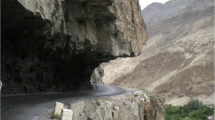Abstract
Tunnel construction is becoming necessary as cities continue to grow, particularly in crowded locations. Thus, the majority of tunneling projects include creating two parallel tunnels, which known as twin tunnels. The excavation action in a slope constitute a crucial issue due to threaten the stability of the slope during the excavation procedure. In this paper an optimized study has been proposed to obtain the best design for distributing the support system through a huge fill slope. Two main methodologies have been proposed to get the optimized design for the support system. The first one is by making a physical model. While, the second one is through the numerical simulation using Plaxis3D software package. Two main modified issues for the support system have been considered: the first is through modifying the dimensions of the support system. The second is through changing the distribution of the support system. However, according to the two proposed cases which are: the case study from Guizhou site and the optimized one, the results revealed that the settlement has been decreased after modifying the usage of the support system in the optimal case.






















Similar content being viewed by others
Data availability
Data is available upon request.
References
Bilgin N (2009) Factors affecting the economy and the efficiency of metro tunnel drivage with two TBM’s in Istanbul in very fractured rock. In: ITA-World Tunnel Congress, Budapest, Hungary
Causse L, Roger C, Jean AF (2015) Interactions between tunnels and unstable slopes: role of excavation. In: Engineering geology for society and territory, pp 237–242
Chongqing Urban Rural Construction Commission (2013) GB 50330–2013 Technical code for building slope engineering. China Architecture & Building Press, Beijing (in Chinese)
Ellis, D (2005) High standards on Heathrow's ART. Tunn Tunnel Int 37(9)
Fumagalli E (2013) Statical and geomechanical models. Springer Science & Business Media
He Z, Li C, He Q et al (2020) Numerical parametric study of countermeasures to alleviate the tunnel excavation effects on an existing tunnel in a shallow-buried environment near a Slope. Appl Sci 10(2):608
Jiang Y (1993) Theoretical and experimental study on the stability of deep underground opening
Karakus M, Ozsan A, Başarır H (2007) Finite element analysis for the twin metro tunnel constructed in Ankara Clay. Bull Eng Geol Env 66(1):71–79
Lü X, Zhou Y, Huang M et al (2018) Experimental study of the face stability of shield tunnel in sands under seepage condition. Tunn Undergr Space Technol 74:195–205
Marinos P, Hoek E (2006) The construction of the Egnatia Highway through unstable slopes in northern Greece. In: Proc. XI Conference on Rock Mechanics, Turin
O'reilly, Myles P, Bm N (1982) Settlements above tunnels in the United Kingdom-their magnitude and prediction. Int J Rock Mech Min Sci, p 090048862X.
Pelizza S, Peila D (1993) Soil and rock reinforcements in tunneling. Tunn Undergr Space Technol 8(3):357–372
Sasiharan N, et al (2005) Analysis of global stability, anchor spacing, and support cable loads in wire mesh and cable net slope protection systems. 1913(1): 205–213
Suwansawat S, Einstein HH (2006) Artificial neural networks for predicting the maximum surface settlement caused by EPB shield tunneling. Tunn Undergr Space Technol 21(2):133–150
Vlachopoulos N (2009) Back analysis of a tunnelling case study in weak rock of the alpine system in northern Greece: validation and optimization of design analysis based on ground characterization and numerical simulation. Queen’s University
Vlachopoulos NI, Vazaios BM, Madjdabad (2018) Investigation into the influence of excavation of twin-bored tunnels within weak rock masses adjacent to slopes. Can Geotech J 55(11):1533–1551
Wei Z et al (2012) Stability analysis and supporting system design of a high-steep cut soil slope on an ancient landslide during highway construction of Tehran–Chalus. 67: 1651–1662.
Zhang T, Taylor RN, Divall S et al (2019) Explanation for twin tunnelling-induced surface settlements by changes in soil stiffness on account of stress history. Tunn Undergr Sp Technol 85:160–169
Zhang P, Chen RP, Wu HN et al (2020) Ground settlement induced by tunneling crossing interface of water-bearing mixed ground: A lesson from Changsha, China. Tunnel Undergr Sp Technol 96:103224
Zhu WS, Zhang Q, Zhu HH et al (2010) Large-scale geomechanical model testing of an underground cavern group in a true three-dimensional (3-D) stress state. Can Geotech J 47(9):935–946
Acknowledgements
This work was supported by the National Key R&D Program of China (Grant No. 581 2018YFC1504802), National Natural Science Foundation of China (Grant No.41972266).
Author information
Authors and Affiliations
Contributions
No conflict of interests
Corresponding author
Ethics declarations
Conflict of interest
The authors have not disclosed any competing interests.
Additional information
Publisher's Note
Springer Nature remains neutral with regard to jurisdictional claims in published maps and institutional affiliations.
Rights and permissions
Springer Nature or its licensor (e.g. a society or other partner) holds exclusive rights to this article under a publishing agreement with the author(s) or other rightsholder(s); author self-archiving of the accepted manuscript version of this article is solely governed by the terms of such publishing agreement and applicable law.
About this article
Cite this article
Suliman, L., Liu, X., Zhou, X. et al. Optimizing stability design of support system for the parallel tunnels excavation crossing a fill slope. Environ Earth Sci 83, 230 (2024). https://doi.org/10.1007/s12665-024-11520-6
Received:
Accepted:
Published:
DOI: https://doi.org/10.1007/s12665-024-11520-6




